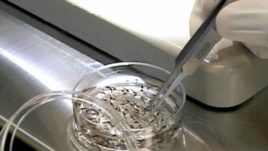VOA慢速英语:在世界范围内抗击疟疾似乎有成功的趋势
From VOA Learning English, this is Science in theNews.
I’m Anna Matteo.
And I’m Christopher Cruise.
Today we will tell about malaria and efforts to defeat it.
Scientists say progress in medical research couldreduce the number and severity of malaria casesworldwide. The World Health Organization reportedrecently that there has been great progress in the fightagainst the disease.
World Malaria Day
Many countries are organizing activities in honor of World Malaria Day thisMonday, April 7th. The events will call attention to malaria and internationalefforts against it. The World Health Organization reports there were about 207million cases of the disease and an estimated 627,000 malaria deaths in 2012. Most deaths were among children living in Africa. The WHO says achild there dies every minute from the disease.
Most cases of malaria are in African countries, south of one of the world’sbiggest deserts -- The Sahara. Malaria also is a health threat to people living inparts of Asia, Central and South America, the Middle East, and southeasternEurope. People from malaria-free countries who visit areas with high rates ofmalaria are also very much at risk. This is because their bodies have little or no resistance to the disease.
The cause of malaria is a parasite called plasmodium. Mosquitoes infectedwith plasmodium spread the disease to human beings through mosquitobites. The parasites reproduce in the human liver, and then infect red bloodcells. After they enter the blood cells, they reproduce again. As they do this,they destroy the cells.
Signs of the disease appear in victims 10 to 15 days after they are bitten.People with malaria develop a high body temperature. They also can becomeweak, violently expel material from the stomach, and suffer pain in the head ormuscles. If not treated, malaria can make the victim sick and even causedeath.
 |
|
Plasmodium vivax |
A parasite called plasmodium falciparum is responsible for most malariainfections. But experts say a lesser-known form of the disease could becomea more serious threat in the future. They are seeing an increase in infectionsfrom the plasmodium vivax parasite.
An estimated 2.5 billion people live in areas whereplasmodium vivax is common. Until recently, expertsbelieved 95 percent of the at-risk population in someareas was protected from vivax infection. This wasbecause they lack a protein in their red blood cellscalled a “Duffy” protein. Without it, vivax parasitescannot enter the blood cells. But researchers havefound that in Madagascar, people without the Duffyprotein may be carrying the vivax parasite. They say itappears the parasite may be changing so it can fight off natural resistanceand infect blood cells that lack the Duffy protein.
Worldwide Fight Against Malaria Appears to Be Succeeding
Researchers remain concerned about the rising number of vivax malariacases. But the worldwide effort against malaria appears to be succeeding. The World Health Organization recently reported that millions of lives havebeen saved since 2000 with better prevention and better medicines. Andhealth officials expect even more success as governments and private groupstarget African countries like Kenya.
The WHO’s latest report on malaria says three millionpeople -- most of them children -- have been saved. And it says the death rate has been cut almost in half.
 |
|
A mother gently places her son in a basket as she takes him to a medical clinic after he became infected withmalaria, in Lankien, Southern Sudan. |
Dr. Robert Newman heads the organization’s globalmalaria program.
“There’s been a large increase over the last 12 years infinancing for malaria control efforts, and that haspurchased life-saving commodities like long-lastinginsecticide-treated bed nets, insecticides for indoorspraying, diagnostic tests -- especially rapid diagnostic tests -- and anti-malarial medicines.”
Malaria is a serious problem in more than 100 countries. Dr. Newman expectsthe number of deaths from malaria to drop even more over the next 10 years.
“I do think that we are going to see an incredible decade of success ahead,especially as people realize that this is a proven public health investment, thatthere's a tremendous return on the investments that are made year to date, and that we have millions more lives that can be saved over the next 10years.”
He predicts a vaccine will be ready within 20 years that will reduce the numberof cases by 75 percent.
Experts say without malaria, productivity will increase. People will be betterable to provide food for their families. And they can spend the money theywould use on anti-malarial drugs on other things. Countries can giveincreased attention to other health needs.
Dr. Joy Phumaphi works with the African Leaders Malaria Alliance.
“Once you don’t have children’s wards in hospitals dominated by malaria, bychildren suffering from malaria, like you currently have in a lot of theseendemic countries, you are going to free up a lot of resources that are going tocombat the other diseases that are challenging our communities.”
Controlling Malaria
Issues in the fight against malaria include a growing resistance to anti-malarialdrugs and insecticide products. But Dr. Newman says there is an even biggerthreat.
“The most serious threat to malaria control and ultimate elimination is actuallya financial one.”
The main effort to control malaria involves treatment ofbed nets and indoor living areas with insecticides --products used to kill insects. The WHO saysinsecticide use has greatly reduced the number ofmalaria cases. It says insecticide-treated bed nets havebeen shown to reduce the number of malaria cases by 50 percent and the infection rate by 90 percent.
“Here’s a tale without an ending, about a princess thatneeds defending…”
 |
|
A mother and her child sit on a bed covered with a mosquito net near Bagamoyo, 70 km north of Tanzanian capitalDar es Salaam. |
Recently, the Against Malaria Foundation worked with a group of students tocreate a short video about the dangers of malaria. Film star Susan Sarandonbecame interested in their work. She volunteered to serve as the announcerfor the video project.
“The evil King Malaria fed. His parasites then began to spread. Through thecells and to the liver. Her blood becomes a deadly river.”
In the video, a little girl is seen falling asleep. You would think she might havea peaceful dream of a child. But instead, a large mosquito attacks the girl, and she becomes infected with malaria.
“This nightmare is a worldwide threat, yet the simplest thing can stop it - a net. It’s such a small thing to buy; so, millions like the princess will not die.”
That was actress Susan Sarandon in “Nightmare,” a short animated videowarning about the dangers of malaria.
The UN Children’s Fund and other organizations supply bed nets to affectedareas. Agencies that offer help to prevent and treat malaria say they have onlyhalf the money they need. Without financial help, the groups warn, gains will be stopped.
Early identification and drug treatment can reduce the severity of malaria andprevent death. The anti-malarial drug chloroquine was widely used until recentyears when the malaria parasite became resistance to the drug. Now, theWHO advises use of artemisinin-based combination treatments, or ACTs, formalaria patients.
The WHO says the international community is now in a position to defeatmalaria. It says that, with the use of insecticides, better testing and drugtreatments, the world could reach its goal of zero malaria deaths by 2015.Still, it says, there is an immediate need for the international community tocontinue and increase its investment in the fight against malaria.
Laser-Beam Scanner Tests for Malaria
Researchers have developed what they are calling the first non-invasivemethod of identifying a malaria infection in the human body. They are nowusing a laser beam scanner to test for the disease without opening up thebody. The test is painless, does not require blood from a person, and appearsto be right every time it is done.
Currently, medical workers study a blood sample under a microscope forevidence of the deadly parasite. The test requires a trained technician, costlyequipment and time -- things that are not always available in poorercountries.
The new device only requires a person to place a finger on a laser device. Dr.Dmitri Lopotko is a researcher at Rice University in Houston, Texas.
“We shine a very short light pulse through the skin. And this light pulse isabsorbed only by malaria parasites because of the wavelength we use. And inresponse to this short light pulse, the parasite literally explodes.”
The light comes from a low-powered laser. The device has less power than alaser pointer. It shines on a very small particle called hemozoin. The malariaparasite produces the particle after it has infected red blood cells. Hemozoincrystals are not found in normal red blood cells.
As the laser heats the crystals, they create small bubbles inside infected cells.Dr. Lopotko says the bubbles explode, and then make a sound that scientistscan hear and count.
“You can detect just (a) few infected cells by a million normal cells.”
Dr. Lopotko says when researchers tested the device it was never wrong, and it was able to find malaria infection early, when treatment is very important.
The device can be carried, and depends on battery power. It costs about$10,000 to $20,000 to manufacture. But Dr. Lopotko says that is not a lot ofmoney if one considers the number of people it can test.
“Each device will be capable to screen more than 200,000 people per year. Sothe cost of analysis for each patient will be less than 50 cents.”
People without medical training can use the device to discover whether peopleare infected with malaria.
Dr. Lopotko says the light beam has shown to be safe in volunteers.Researchers will now test the device at a Houston hospital that cares forpatients infected with malaria. If those tests are successful, researchers willtest the device throughout the world this year.
A report describing the malaria detection device was published in the journalProceedings of the National Academy of Sciences.
This Science in the News was written and produced by Christopher Cruise, from reports by Carol Pearson and Jessica Berman in Washington.
I’m Anna Matteo.
And I’m Christopher Cruise.
Join us again next week for more news about science on the Voice ofAmerica.
- 频道推荐
- |
- 全站推荐
- 推荐下载
- 网站推荐




















